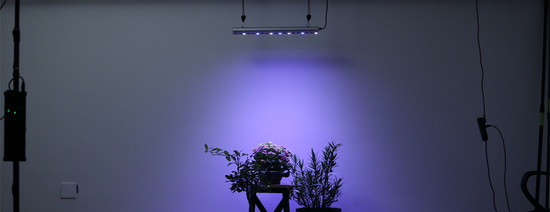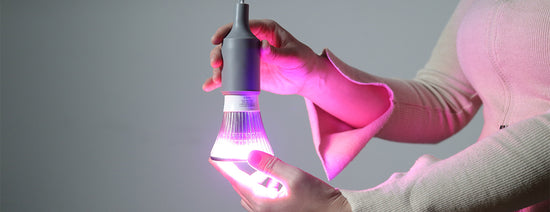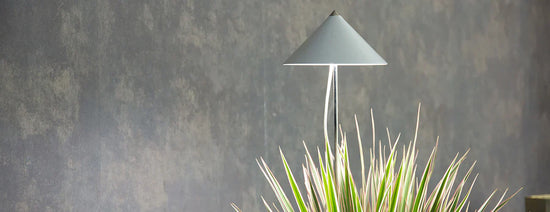Cultivation and growth with the help of plant light
The growing season usually begins in February or March, so that the beds and gardens can be equipped with the specially grown seedlings in May. It is best grown in the greenhouse or indoors on the sunny windowsill. The lack of sunlight in winter often causes the plants to stretch. This can be prevented with the right LED plant light. An extension of the garden season is also possible through early cultivation indoors.
In addition to the influencing factors of seed, temperature and substrate, the necessary light is the limiting factor when growing indoors. In the wintertime, certain wavelengths are also missing in the sunlight, which is scarce anyway. In order to provide the seedlings with the best possible light, the best way to help them is with plant lighting, ideally with LEDs. This also achieves independence from sunlight. Due to the lack of light in winter or on the north window, there is a risk that the sprout will shoot up and thus an imbalance in the growth of the plant (overgrowth). The aim is to promote the growth of the leaves, the shoot and, above all, the root apparatus evenly, so that all three areas of the plant grow in a healthy relationship to one another. The goal is a strong, stable shoot, firm, juicy leaves and an extensive root ball.

For cultivation, it is important to use lamps for plant growth that have a spectrum of all wavelength ranges that are important for growth. The lamps used are then ideally equipped with 5 different wavelength ranges: a white full spectrum 400-700nm, a dark (around 430nm) and light blue (around 450nm), and a red (around 640nm) and deep red (around 660nm) wavelength range. The combination of these areas creates an ideal spectrum for cultivation in order to stimulate the chlorophyll production and photosynthesis of the plants in the best possible way.
cultivation types
Sowing is a generative method of propagation. This is when seedlings are formed from the seeds of the parent plants. One speaks of sexual reproduction. The young plants differ genetically from the parent plants, resulting in genetic diversity.
In vegetative propagation, i.e. asexual propagation, a new, almost identical plant (clone) is formed from a plant part of a mother plant. This can be done via offshoots, cuttings or sinkers. This is especially interesting for preserving the properties of the mother plant.
grow guide
The right time
When using full-spectrum grow lights, the timing of propagation is very flexible. The earlier you start, the more time the plants have to develop vital roots and foliage. Some growth or cultivation lamps have a dimming function to be able to control them better. In general, you can start in January or February with the use of plant growth lamps. Without lamps, it is advisable to wait until the end of March/April, since the full spectral range will not be available in the sunlight until April (risk of smearing). The subsequent exposure to the open air should be adapted to the respective plant species. It is particularly important to note the frost hardiness of the plants. In the best case, wait until after the ice saints.


The Sowing
Scatter or lay out the seeds individually on the respective substrate. Potting soil or coconut substrate are best suited for this, as they are poorer in nutrients and the plants are therefore not overfed and develop more roots. It is best to choose the substrate with which you have had the best experience.
Tip: If you fill your growing container half with conventional substrate and half with one of the two growing substrates mentioned, then the plants will form a pronounced and deep root system more quickly because they want to get into the more nutrient-rich substrate. Cultivation pots, which are available in round and square shapes and many different sizes, are ideal as cultivation vessels. These can also be connected to one another in the form of a pallet.
When watering, please make sure to water the seeds carefully with a fine atomizer or a drip attachment for your watering can so that you don't wash away the seeds. The seeds should be pressed and covered with a fine layer of substrate or sand.
The germination
Make sure the seeds are never allowed to dry out. Especially when growing indoors, the risk of the seed drying out is high due to dry heating air. For this reason, it is advisable to use a room or mini greenhouse. These keep a certain level of humidity constant, but must be ventilated daily so that no fungal spores can form. For germination, the seeds need sufficient warmth (~25°C) and high humidity (>60%).
Advantages of growing with grow lights
If you use artificial light from the LEDs, you can start sowing much earlier , since in most regions of Europe it is still too dark in January and February for sowing with natural daylight. The plants grow stronger and much more compact during cultivation in artificial light and therefore do not have to be hardened off for so long later when going outdoors. The plant lights, which can be used very universally, enable cultivation and rearing  t also in dark apartments or with narrow window sills. Theoretically, with the help of the lamps, you can even move the cultivation to the basement! If a plant shelf is also purchased, many plants can also be grown in a smaller footprint .
t also in dark apartments or with narrow window sills. Theoretically, with the help of the lamps, you can even move the cultivation to the basement! If a plant shelf is also purchased, many plants can also be grown in a smaller footprint .
Which plant lamps are best for growing?
In principle, we advise you to use artificial light from LED lights , as they consume significantly less electricity and are also very durable. These are crucial differences and advantages compared to conventional plant lamps. While the light intensity and illumination in LUX and lumen are measured with "normal" lamps for lighting living spaces and the brightness primarily plays a role, with plant lamps the photosynthetically active radiation (PAR) is of great importance.
The red and blue wavelengths are primarily responsible for the photosynthesis of plants , which is why some plant lamps only consist of LEDs of the blue and red spectrum . Unfortunately, these are unsuitable for installation in the living area, as the room is shrouded in a purple glow. That is why we offer you lamps in which the light also has green components and therefore appears white overall.





